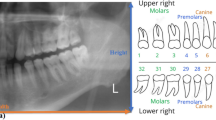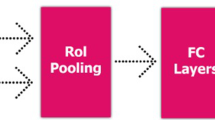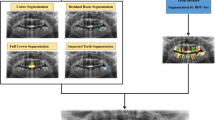Abstract
Objective
This study aims to investigate the effect of number of data on model performance, for the detection of tooth numbering problem on dental panoramic radiographs, with the help of image processing and deep learning algorithms.
Study Design
The data set consists of 3000 anonymous dental panoramic X-rays of adult individuals. Panoramic X-rays were labeled on the basis of 32 classes in line with the FDI tooth numbering system. In order to examine the relationship between the number of data used in image processing algorithms and model performance, four different datasets which include 1000, 1500, 2000 and 2500 panoramic X-rays, were used. The training of the models was carried out with the YOLOv4 algorithm and trained models were tested on a fixed test dataset with 500 data and compared based on F1 score, mAP, sensitivity, precision and recall metrics.
Results
The performance of the model increased as the number of data used during the training of the model increased. Therefore, the last model trained with 2500 data showed the highest success among all the trained models.
Conclusion
Dataset size is important for dental enumeration, and large samples should be considered as more reliable.




Similar content being viewed by others
Data availibility
The data used to support the findings of this study are available from the corresponding author upon request.
References
Ramesh AN, Kambhampati C, Monson JRT, Drew PJ. Artificial intelligence in medicine. Ann R Coll Surg Engl. 2004;86(5):334–8.
Yu K-H, Beam AL, Kohane IS. Artificial intelligence in healthcare. Nat Biomed Eng. 2018;2(10):719–31.
Davenport T, Kalakota R. The potential for artificial intelligence in healthcare. Future Healthc J. 2019;6(2):94–8.
Jiang F, Jiang Y, Zhi H, Dong Y, Li H, Ma S, Wang Y, Dong Q, Shen H, Wang Y. Artificial intelligence in healthcare: past, present and future. Stroke Vasc Neurol. 2017;2(4):230–43.
Holzinger A, Langs G, Denk H, Zatloukal K, Muller H. Causability and explainability of artificial intelligence in medicine, Wiley Interdiscip. Rev Data Min Knowl Discov. 2019;9(4):e1312.
Whyte A, Matias MATJ. Imaging of orofacial pain. J Oral Pathol Med. 2020;49(6):490–8.
Sur J, Bose S, Khan F, Dewangan D, Sawriya E, Roul A. Knowledge, attitudes, and perceptions regarding the future of artificial intelligence in oral radiology in india: a survey. Imaging Sci Dent. 2020;50(3):193.
Günec HG, Gökyay SS, Kaya E, Cesur-Aydın K. Toplum Yapay Zeka Ile Dental Tani Konmasina Hazir Mı? Selcuk Dental Journal. 2022;9:200–7. https://doi.org/10.15311/selcukdentj.915522.
Keiser-Nielsen S. Fédération Dentaire Internationale two-digit system of designating teeth. Int Dent J. 1971;21:104–6.
Tzutalin, Labelimg, Gitcode https://github.com/tzutalin/labelImg, [accessed 20 Oct 2021] (2015)
A. Bochkovskiy, C. Wang, H. M. Liao, Yolov4: Optimal speed and accuracy of object detection, CoRR abs/2004.10934 (2020). arXiv:2004.10934. Accessed on 23 Apr 2020
Tuzoff DV, Tuzova LN, Bornstein MM, Krasnov AS, Kharchenko MA, Nikolenko SI, Sveshnikov MM, Bednenko GB. Tooth detection and numbering in panoramic radiographs using convolutional neural networks. Dentomaxillofacial Radiology. 2019;48(4):20180051.
Mahdi FP, Yagi N, Kobashi S. Automatic teeth recognition in dental x-ray images using transfer learning based faster r-cnn, in, IEEE 50th International Symposium on Multiple-Valued Logic (ISMVL). IEEE. 2020;2020:16–21.
Muramatsu C, Morishita T, Takahashi R, Hayashi T, Nishiyama W, Ariji Y, Zhou X, Hara T, Katsumata A, Ariji E, et al. Tooth detection and classification on panoramic radiographs for automatic dental chart filing: improved classification by multi-sized input data. Oral Radiol. 2021;37(1):13–9.
Kim C, Kim D, Jeong H, Yoon S-J, Youm S. Automatic tooth detection and numbering using a combination of a cnn and heuristic algorithm. Appl Sci. 2020;10(16):5624.
Muresan MP, Barbura AR, Nedevschi S (2020) Teeth detection and dental problem classification in panoramic x-ray images using deep learning and image processing techniques. In: 2020 IEEE 16th International Conference on Intelligent Computer Communication and Processing (ICCP), IEEE, 2020, pp. 457–463.
Cho J, Lee K, Shin E, Choy G, Do S (2015) How much data is needed to train a medical image deep learning system to achieve necessary high accuracy?, arXiv preprint arXiv:1511.06348
Yüksel AE, Gültekin S, Simsar E, Özdemir ŞD, Gündoğar M, Tokgöz SB, Hamamcı İE. Dental enumeration and multiple treatment detection on panoramic X-rays using deep learning. Sci Rep. 2021;11(1):1–10.
Acknowledgements
The authors declare that they have no known competing financial interests or personal relationships that could have appeared to influence the work reported in this paper.
Funding
Not applicable
Author information
Authors and Affiliations
Contributions
KCA: conceptualization, methodology, ınvestigation, writing—original draft preparation, writing—reviewing and editing, visualization. SK: methodology, ınvestigation, software, validation, data curation, ınvestigation, writing—original draft preparation. SG: methodology, ınvestigation, software, validation, data curation, ınvestigation, writing—original draft preparation, resources. GA: methodology, project administration, supervision. AA: software, validation, resources.
Corresponding author
Ethics declarations
Conflicts of interest
All authors declare that they have no conflict of interest.
Ethics approval
Not applicable. This article does not contain any studies with human or animal subjects performed by any of the authors.
Informed consent
Not applicable
Additional information
Publisher's Note
Springer Nature remains neutral with regard to jurisdictional claims in published maps and institutional affiliations.
Rights and permissions
Springer Nature or its licensor (e.g. a society or other partner) holds exclusive rights to this article under a publishing agreement with the author(s) or other rightsholder(s); author self-archiving of the accepted manuscript version of this article is solely governed by the terms of such publishing agreement and applicable law.
About this article
Cite this article
Gülüm, S., Kutal, S., Cesur Aydin, K. et al. Effect of data size on tooth numbering performance via artificial intelligence using panoramic radiographs. Oral Radiol 39, 715–721 (2023). https://doi.org/10.1007/s11282-023-00689-4
Received:
Accepted:
Published:
Issue Date:
DOI: https://doi.org/10.1007/s11282-023-00689-4




